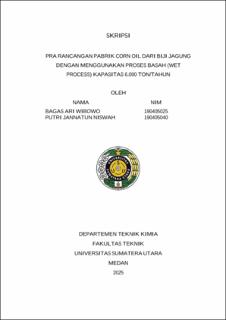| dc.description.abstract | Corn oil is an oil obtained through the extraction or pressing of corn kernels. Corn oil is often used as a substitute option for palm oil as it is considered to have a lower saturated fatty acid content. The process of making corn oil generally uses the rendering method. The rendering process aims to produce oil from a material that is predicted to have oil content such as corn. Wet rendering is a rendering process carried out by adding a certain amount of water during the process. This plant is designed with a capacity of 6,000 tons/year, using corn kernels as raw material, as well as bentonite and NaOH as supporting materials. The plant operates for 330 days a year. The location of this plant is planned to be established in Dolok Hataran Village, Siantar District, Simalungun Regency, North Sumatra with a land area of 10,004.5 m2 and a total of 179 employees with the form of a Limited Liability Company (PT) led by a director with an organizational system and staff. The results of the economic analysis of this plant are capital investment of Rp. 2,860,761,515,075, total cost of Rp. 981,854,201,614,905, sales process of Rp. 2,412,942,042,791, net profit of Rp. 715,190,378,769, PM of 45.562%, BEP of
49.9%, ROI of 25%, RON of 42%, and POT of 4 years. Based on the results of the economic analysis, it can be concluded that the corn oil plant from corn kernels with wet process. | en_US |


